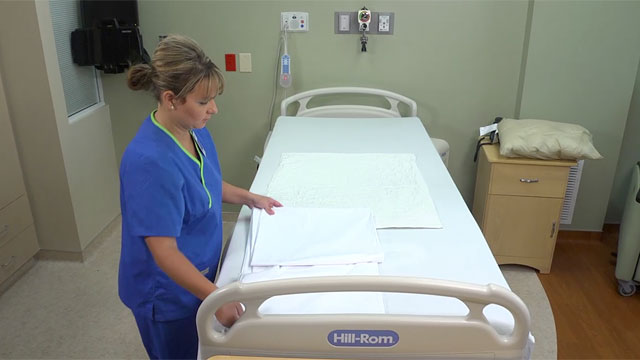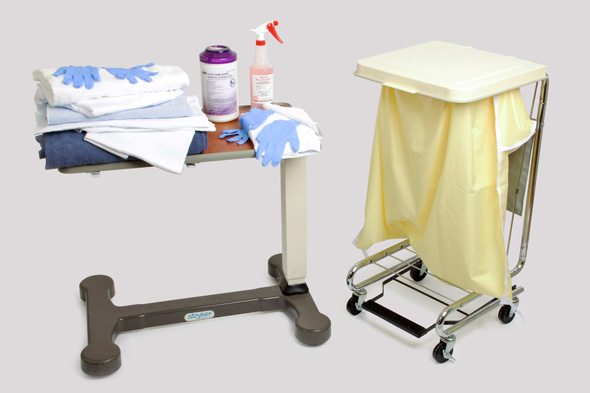Bedmaking
Select a Skill:
Take the Review Test:

Safety
- Use Standard Precautions when making a surgical bed.
- Be sure to wear clean gloves to remove soiled linen. Hold soiled linen away from your uniform, and avoid shaking or fanning it.
- Assess the environment for safety, such as checking the room for spills and making sure equipment is working properly.
- Use proper body mechanics when making a surgical bed.
- Be sure to lock the wheels on the bed to prevent accidental movement while making the bed.
- Remember to lower the side rails when preparing to make the bed.
Equipment
(Roll cursor over items to see labels)

Bottom Sheet (flat or fitted) and Drawsheet (optional)
Large, quilted waterproof pad (optional)
Top sheet
Bath blanket
Bedspread
Pillowcases
Clean gloves
Antiseptic cleanser or wipes
Towels or washcloth
Linen bag
Delegation
The skill of making a surgical bed can be delegated to nursing assistive personnel (NAP). Be sure to inform NAP of the following:
- Specify that Standard Precautions are to be used when making a surgical bed.
- Specify any position or activity restrictions that can be expected when the patient returns.
- Specify any special linen instructions, such as when the patient is on an airflow mattress.
Preparation
- Perform hand hygiene
- Use Standard Precautions when making a surgical bed. Wear gloves when removing soiled linen. Assess the environment for safety, such as checking the room for spills and making sure equipment is working properly.
- Assemble all equipment on the clean and dry bedside table.
- Use body mechanics principles when making the bed.
- Adjust the bed to working height. Lower the side rails.
Follow-up
- Transfer the patient into bed.
- Ask if the patient is comfortable.
- Ensure that the call light is within the patient's reach.
- Periodically check the linen for cleanliness and tightness.
Documentation
The making of a surgical bed is not documented in the medical record.
Review Questions
1. When making a surgical bed with no patient present, at which time is it unnecessary to perform hand hygiene?
 Before making the bed
Before making the bed After gloving, washing the mattress with an antiseptic solution, and ungloving
After gloving, washing the mattress with an antiseptic solution, and ungloving After disposing of soiled linen that is not visibly soiled
After disposing of soiled linen that is not visibly soiled After fanfolding the sheets to complete the open bed
After fanfolding the sheets to complete the open bed
2. A new nursing assistive personnel (NAP) is making a surgical bed for a patient who is having abdominal surgery. Where will you instruct the NAP to place the waterproof pad on this bed?
 Over the mattress
Over the mattress Over the bottom sheet
Over the bottom sheet Over the top sheet
Over the top sheet A waterproof pad should not be used for this patient.
A waterproof pad should not be used for this patient.
3. For a surgical bed, why is the linen formed into a triangle and fanfolded away from the side on which the patient will be transferred?
 To protect the linen from soiling
To protect the linen from soiling To ensure that the toe pleat is not pulled out
To ensure that the toe pleat is not pulled out To keep the linen out of the way during the transfer
To keep the linen out of the way during the transfer  To keep the flat sheet taut during the transfer
To keep the flat sheet taut during the transfer
4. A nursing assistive personnel (NAP) has finished making a surgical bed for a patient in surgery. How would the nurse instruct the NAP to leave the bed to transfer the surgical patient safely?
 Raise the head of the bed to a 30-degree angle.
Raise the head of the bed to a 30-degree angle.  Raise the top two side rails.
Raise the top two side rails. Raise the height of the bed.
Raise the height of the bed. Release the bed wheels.
Release the bed wheels.
5. When making a surgical bed, why does the nurse avoid shaking the linen being removed from the bed?
 To keep the linen folded correctly
To keep the linen folded correctly To prevent contamination to the environment and the nurse’s uniform
To prevent contamination to the environment and the nurse’s uniform  To keep it separate from the towels and washcloths in the linen bag
To keep it separate from the towels and washcloths in the linen bag To reduce the amount of time needed to make the bed
To reduce the amount of time needed to make the bed
You have completed the Review Questions for this skill. To take the Review again select the Start Over button. To proceed to another skill select from the dropdown menu. Select the Home or Back button to proceed to the next section.

